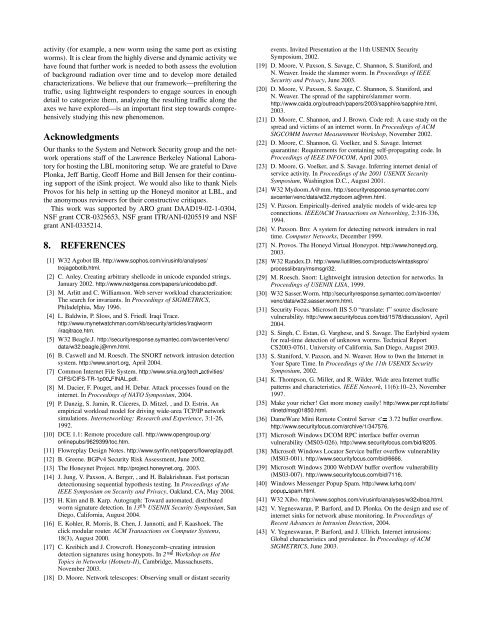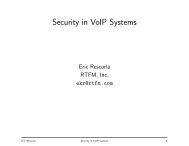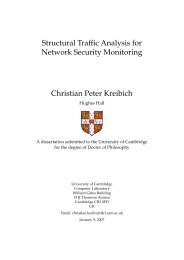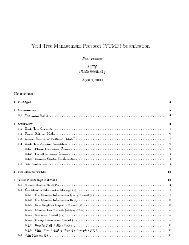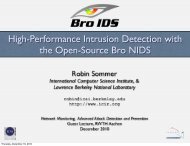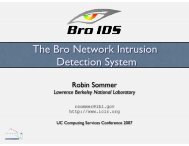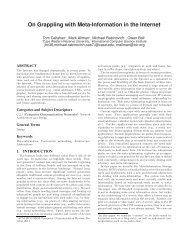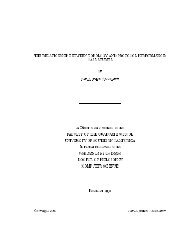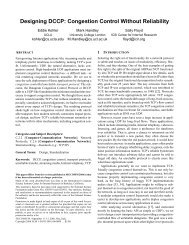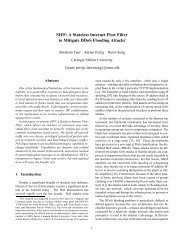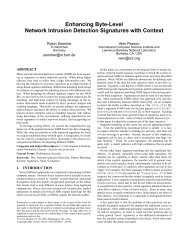Characteristics of Internet Background Radiation - UNC Computer ...
Characteristics of Internet Background Radiation - UNC Computer ...
Characteristics of Internet Background Radiation - UNC Computer ...
Create successful ePaper yourself
Turn your PDF publications into a flip-book with our unique Google optimized e-Paper software.
activity (for example, a new worm using the same port as existing<br />
worms). It is clear from the highly diverse and dynamic activity we<br />
have found that further work is needed to both assess the evolution<br />
<strong>of</strong> background radiation over time and to develop more detailed<br />
characterizations. We believe that our framework—prefiltering the<br />
traffic, using lightweight responders to engage sources in enough<br />
detail to categorize them, analyzing the resulting traffic along the<br />
axes we have explored—is an important first step towards comprehensively<br />
studying this new phenomenon.<br />
Acknowledgments<br />
Our thanks to the System and Network Security group and the network<br />
operations staff <strong>of</strong> the Lawrence Berkeley National Laboratory<br />
for hosting the LBL monitoring setup. We are grateful to Dave<br />
Plonka, Jeff Bartig, Ge<strong>of</strong>f Horne and Bill Jensen for their continuing<br />
support <strong>of</strong> the iSink project. We would also like to thank Niels<br />
Provos for his help in setting up the Honeyd monitor at LBL, and<br />
the anonymous reviewers for their constructive critiques.<br />
This work was supported by ARO grant DAAD19-02-1-0304,<br />
NSF grant CCR-0325653, NSF grant ITR/ANI-0205519 and NSF<br />
grant ANI-0335214.<br />
8. REFERENCES<br />
[1] W32 Agobot IB. http://www.sophos.com/virusinfo/analyses/<br />
trojagobotib.html.<br />
[2] C. Anley. Creating arbitrary shellcode in unicode expanded strings,<br />
January 2002. http://www.nextgenss.com/papers/unicodebo.pdf.<br />
[3] M. Arlitt and C. Williamson. Web server workload characterization:<br />
The search for invariants. In Proceedings <strong>of</strong> SIGMETRICS,<br />
Philadelphia, May 1996.<br />
[4] L. Baldwin, P. Sloss, and S. Friedl. Iraqi Trace.<br />
http://www.mynetwatchman.com/kb/security/articles/iraqiworm<br />
/iraqitrace.htm.<br />
[5] W32 Beagle.J. http://securityresponse.symantec.com/avcenter/venc/<br />
data/w32.beagle.j@mm.html.<br />
[6] B. Caswell and M. Roesch. The SNORT network intrusion detection<br />
system. http://www.snort.org, April 2004.<br />
[7] Common <strong>Internet</strong> File System. http://www.snia.org/tech activities/<br />
CIFS/CIFS-TR-1p00 FINAL.pdf.<br />
[8] M. Dacier, F. Pouget, and H. Debar. Attack processes found on the<br />
internet. In Proceedings <strong>of</strong> NATO Symposium, 2004.<br />
[9] P. Danzig, S. Jamin, R. Cáceres, D. Mitzel, , and D. Estrin. An<br />
empirical workload model for driving wide-area TCP/IP network<br />
simulations. <strong>Internet</strong>working: Research and Experience, 3:1-26,<br />
1992.<br />
[10] DCE 1.1: Remote procedure call. http://www.opengroup.org/<br />
onlinepubs/9629399/toc.htm.<br />
[11] Flowreplay Design Notes. http://www.synfin.net/papers/flowreplay.pdf.<br />
[12] B. Greene. BGPv4 Security Risk Assessment, June 2002.<br />
[13] The Honeynet Project. http://project.honeynet.org, 2003.<br />
[14] J. Jung, V. Paxson, A. Berger, , and H. Balakrishnan. Fast portscan<br />
detectionusing sequential hypothesis testing. In Proceedings <strong>of</strong> the<br />
IEEE Symposium on Security and Privacy, Oakland, CA, May 2004.<br />
[15] H. Kim and B. Karp. Autograph: Toward automated, distributed<br />
worm signature detection. In 13 USENIX Security Symposium, San<br />
Diego, California, August 2004.<br />
[16] E. Kohler, R. Morris, B. Chen, J. Jannotti, and F. Kaashoek. The<br />
click modular router. ACM Transactions on <strong>Computer</strong> Systems,<br />
18(3), August 2000.<br />
[17] C. Kreibich and J. Crowcr<strong>of</strong>t. Honeycomb–creating intrusion<br />
detection signatures using honeypots. In 2 Workshop on Hot<br />
Topics in Networks (Hotnets-II), Cambridge, Massachusetts,<br />
November 2003.<br />
[18] D. Moore. Network telescopes: Observing small or distant security<br />
events. Invited Presentation at the 11th USENIX Security<br />
Symposium, 2002.<br />
[19] D. Moore, V. Paxson, S. Savage, C. Shannon, S. Staniford, and<br />
N. Weaver. Inside the slammer worm. In Proceedings <strong>of</strong> IEEE<br />
Security and Privacy, June 2003.<br />
[20] D. Moore, V. Paxson, S. Savage, C. Shannon, S. Staniford, and<br />
N. Weaver. The spread <strong>of</strong> the sapphire/slammer worm.<br />
http://www.caida.org/outreach/papers/2003/sapphire/sapphire.html,<br />
2003.<br />
[21] D. Moore, C. Shannon, and J. Brown. Code red: A case study on the<br />
spread and victims <strong>of</strong> an internet worm. In Proceedings <strong>of</strong> ACM<br />
SIGCOMM <strong>Internet</strong> Measurement Workshop, November 2002.<br />
[22] D. Moore, C. Shannon, G. Voelker, and S. Savage. <strong>Internet</strong><br />
quarantine: Requirements for containing self-propagating code. In<br />
Proceedings <strong>of</strong> IEEE INFOCOM, April 2003.<br />
[23] D. Moore, G. Voelker, and S. Savage. Inferring internet denial <strong>of</strong><br />
service activity. In Proceedings <strong>of</strong> the 2001 USENIX Security<br />
Symposium, Washington D.C., August 2001.<br />
[24] W32 Mydoom.A@mm. http://securityresponse.symantec.com/<br />
avcenter/venc/data/w32.mydoom.a@mm.html.<br />
[25] V. Paxson. Empirically-derived analytic models <strong>of</strong> wide-area tcp<br />
connections. IEEE/ACM Transactions on Networking, 2:316-336,<br />
1994.<br />
[26] V. Paxson. Bro: A system for detecting network intruders in real<br />
time. <strong>Computer</strong> Networks, December 1999.<br />
[27] N. Provos. The Honeyd Virtual Honeypot. http://www.honeyd.org,<br />
2003.<br />
[28] W32 Randex.D. http://www.liutilities.com/products/wintaskspro/<br />
processlibrary/msmsgri32.<br />
[29] M. Roesch. Snort: Lightweight intrusion detection for networks. In<br />
Proceedings <strong>of</strong> USENIX LISA, 1999.<br />
[30] W32 Sasser.Worm. http://securityresponse.symantec.com/avcenter/<br />
venc/data/w32.sasser.worm.html.<br />
[31] Security Focus. Micros<strong>of</strong>t IIS 5.0 “translate: f” source disclosure<br />
vulnerability. http://www.securityfocus.com/bid/1578/discussion/, April<br />
2004.<br />
[32] S. Singh, C. Estan, G. Varghese, and S. Savage. The Earlybird system<br />
for real-time detection <strong>of</strong> unknown worms. Technical Report<br />
CS2003-0761, University <strong>of</strong> California, San Diego, August 2003.<br />
[33] S. Staniford, V. Paxson, and N. Weaver. How to 0wn the <strong>Internet</strong> in<br />
Your Spare Time. In Proceedings <strong>of</strong> the 11th USENIX Security<br />
Symposium, 2002.<br />
[34] K. Thompson, G. Miller, and R. Wilder. Wide area <strong>Internet</strong> traffic<br />
patterns and characteristics. IEEE Network, 11(6):10–23, November<br />
1997.<br />
[35] Make your richer! Get more money easily! http://www.per.rcpt.to/lists/<br />
rlinetd/msg01850.html.<br />
[36] DameWare Mini Remote Control Server 3.72 buffer overflow.<br />
http://www.securityfocus.com/archive/1/347576.<br />
[37] Micros<strong>of</strong>t Windows DCOM RPC interface buffer overrun<br />
vulnerability (MS03-026). http://www.securityfocus.com/bid/8205.<br />
[38] Micros<strong>of</strong>t Windows Locator Service buffer overflow vulnerability<br />
(MS03-001). http://www.securityfocus.com/bid/6666.<br />
[39] Micros<strong>of</strong>t Windows 2000 WebDAV buffer overflow vulnerability<br />
(MS03-007). http://www.securityfocus.com/bid/7116.<br />
[40] Windows Messenger Popup Spam. http://www.lurhq.com/<br />
popup spam.html.<br />
[41] W32 Xibo. http://www.sophos.com/virusinfo/analyses/w32xiboa.html.<br />
[42] V. Yegneswaran, P. Barford, and D. Plonka. On the design and use <strong>of</strong><br />
internet sinks for network abuse monitoring. In Proceedings <strong>of</strong><br />
Recent Advances in Intrusion Detection, 2004.<br />
[43] V. Yegneswaran, P. Barford, and J. Ullrich. <strong>Internet</strong> intrusions:<br />
Global characteristics and prevalence. In Proceedings <strong>of</strong> ACM<br />
SIGMETRICS, June 2003.


